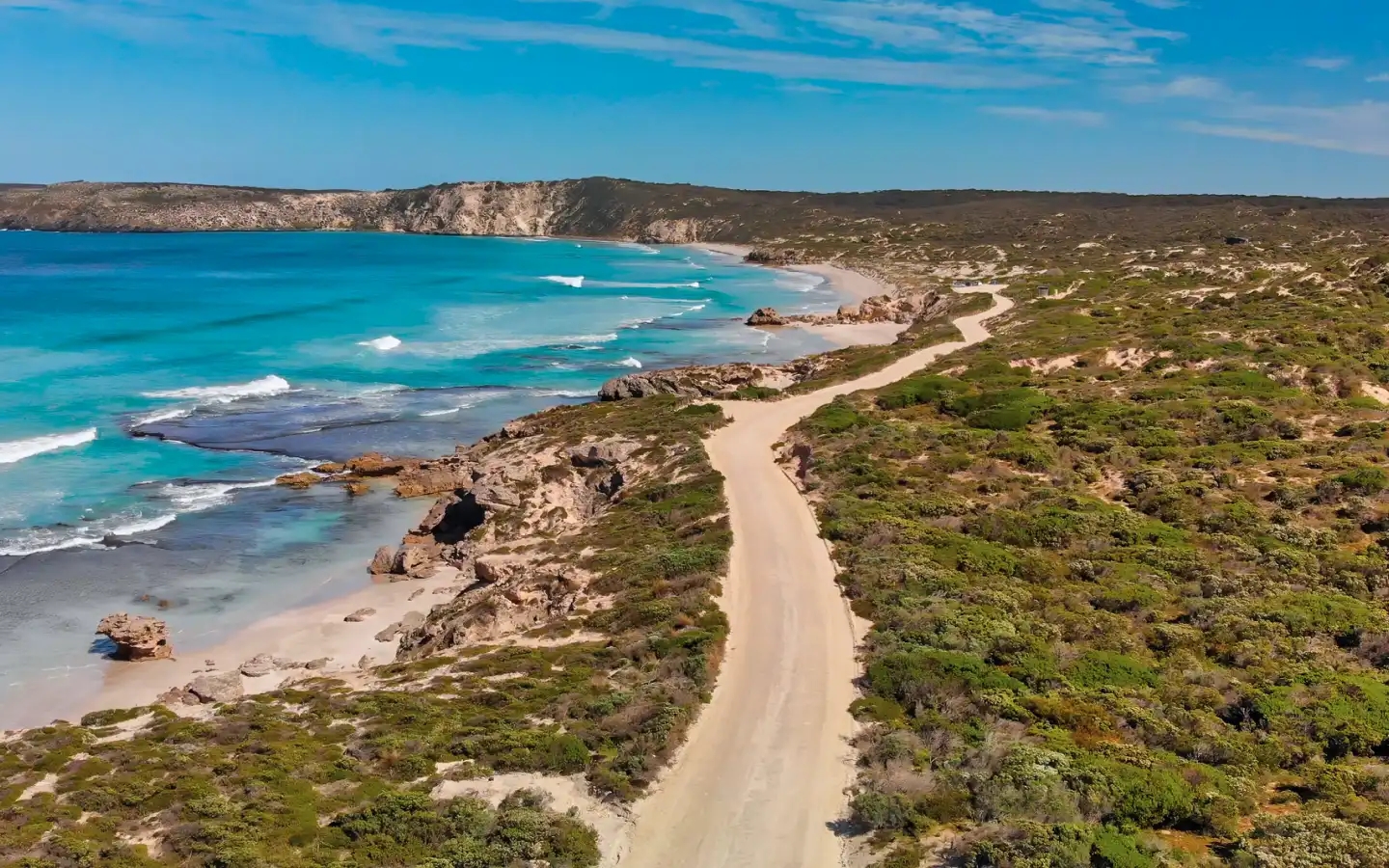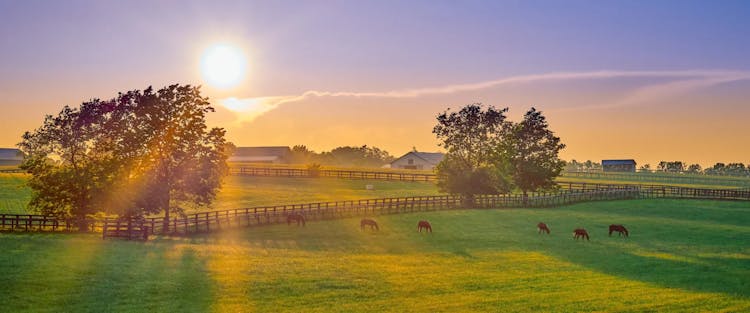
The Australian Island Home to 65,000 Kangaroos
The fearless skills of the koala perched atop the highest branches of the Eucalyptus tree could match any expert gymnast I had ever witnessed. The portly and quite cute koala inched its way from the sturdier, thick branches of the tree onto the less stable, thinner limbs where the tempting clusters of leaves seemed precariously out of reach. It was determined to feast on the tastiest leaves of its favorite food, and I watched its single-minded pursuit with nervous excitement.
I wasn’t alone in observing this aerialist endeavor. I and about six other people were on a guided wildlife tour on Australia’s Kangaroo Island at Hanson Bay Wildlife Sanctuary—considered the best place on the island to see sustainable populations of koalas in the wild.
We were in a forest of Eucalyptus gum trees inhabited by leaf-munching, dozing, and sometimes acrobatic koalas. Native to Australia, there are over 700 species of Eucalyptus that cover the continent, but we learned from our guide that koalas can only survive in this type of thriving Eucalyptus habitat since the leaves are the main source of their diet.
A guest asked if people were allowed to hold a koala. “These are wild creatures living in their natural habitat, so no, you can’t,” said our guide. I could understand the desire to hold the furry little creature. The cuteness factor was way off the charts, and we were all charmed by the little marsupials.

It was hard to leave the scene. We lingered as long as we could, enthralled by the portly koala’s adept “balance beam” walk across the slender branches while nibbling on leaves. A move, I thought, that would make even Simone Biles proud.
Kangaroos, koalas, and wallabies, oh my!
Given the fact that there are lots of koalas on Kangaroo Island, you might wonder why it wasn’t called “Koala Island.” But it’s actually the other marsupial with a name that begins with a “k” that is the preeminent species of the island.
True to its name, Kangaroo Island, which is located eight miles off the coast of South Australia, is home to thousands of Kangaroo Island Kangaroos (a unique sub-species of the Australian Western Grey Kangaroo that is only found here). With an estimated population of around 65,000 individuals, a wildlife encounter with the hopping marsupial is as highly likely today as it was when the first European explorers came upon the island in 1802, observed a prolific population of kangaroos, and thus named the island.
But the kangaroo is just one of the many rare creatures you can spot on a walk through the bush or along a sandy beach on the island. In fact, you can also spot wallabies, koalas, and echidnas; 260 bird species, including parrots, cockatoos, and the wedge-tailed eagle; numerous amphibians and reptiles; plus colonies of fur seals tucked along the rugged coastline and endangered Australian sea lions hanging out on protected beaches at Seal Bay Conservation Park. It’s a range of wildlife you’d have to drive miles and miles to see on the mainland.

Big adventure on a small island
I visited months before the 2020 bushfires swept across many areas of Australia, including Kangaroo Island, scorching 42% of the island. Since then, native habitats and wildlife have made a significant recovery with the aid of the resilient local community. To visit this superabundant “wildlife sanctuary without fences” was the main reason why I made the trek from mainland Australia. And it’s still one of the best places to see some of Australia’s most popular wildlife species in their natural habitat.
Over the course of three days, I ticked off all the animals on my Australia wildlife wish list. I walked along the boardwalks of Seal Bay Conservation Park, the third-largest Australian sea lion colony in Australia, observing the endangered sea lions cavorting on the sandy beach. I visited the west end of the island to take in the gorgeous scenery of Flinders Chase National Park, another area home to endangered koalas, kangaroos, and echidnas. And I was completely enchanted by the wildlife tour at Hanson Bay Wildlife Sanctuary, where the 90-minute guided koala walk was a highlight. Hanson Bay is one of the few places where you can observe dozens of the tiny marsupials in their natural habitat. An addition to the tour since my visit is the inclusion of a bushfire ecology talk where you can learn how instrumental bushfires have been over the centuries in creating the ecology of the island and how species have adapted.
Even though Kangaroo Island is only 96 miles long and 34 miles wide, there’s so much natural beauty and wildlife habitat to cover.
“For many of our guests, this is what they expected Australia to be like,” says Craig Wickham, owner of Exceptional Kangaroo Island tour company, as he showed me around the island one day. The day began with a drive to see koalas tucked into the branches of tall Eucalyptus trees next to a river, then we journeyed on to Wickham’s favorite hotspots for sightings of kangaroos and wallabies.
We stopped alongside the road and gazed out toward the grassy bush, where I glimpsed rare Tammar Wallabies, a marsupial that is much smaller than their kangaroo cousins. The noise of the safari vehicle startled the group, and they quickly scurried to shelter within the leafy foliage of trees. I felt privileged to see them, as Wickham said they were shy creatures and not easy to spot. Lucky for me, he knew where some of the best locations on the island were to see wee wallaby mobs. Wickham held a vast treasure chest of knowledge about Kangaroo Island and shared stories on the history and wildlife riches of the island.
It was hard to pull myself away from the wallabies, but I was promised an elegant picnic lunch in a park setting with “local entertainment”—which turned out to be watching a troupe of kangaroos hop around while I dined. “It’s a lovely afternoon, and they are coming out for a feed,” said Wickham as he donned an apron embellished with kangaroos and poured me a glass of Shiraz Grenache Malbec wine from The Islander Estate Vineyards, one of the island’s seven wineries. Wickham composed the perfect little picnic setting: a cloth-covered table with the addition of a canvas canopy shade that protected us from the afternoon sun.
Ordinarily nocturnal, ‘roos (the Australian nickname for kangaroos) rest during the heat of the day. They usually come out at dawn and late afternoon to graze. However, there is a slim chance they can be found lounging in the comfort of meadows and fields during the daytime hours. With his years of experience living on the island, Wickham has mapped out some of the ‘roos' favorite afternoon spots to seek shelter. Our picnic spot was about 100 feet away so that our presence wouldn’t disturb the ‘roos. I felt very lucky to peer out onto the panoramic parkland where a small group of bouncing herbivores nibbled on blades of grass and others peacefully gathered under the umbrella of leafy trees. Of course, I had the urge to get closer, but they were wild animals. And that’s a big “no-no” regardless of where you are in the world observing wildlife.

As I sipped my local wine, looking at the mob of kangaroos before me, I thought back to Wickham’s comment on how Kangaroo Island is what most people envision Australia to be. In terms of seeing wildlife in their natural habitat, this was exactly the Australia of my dreams.
How to get there
From the United States, fly into Sydney or Melbourne, then take a domestic flight to Adelaide in South Australia. That’s your departure point for direct flights to Kingscote Airport on Kangaroo Island. From Adelaide, Qantas Airlines offers daily 20-minute flights to Kangaroo Island. Alternatively, you could take a ferry to Kangaroo Island from the mainland. Sealink offers a 45-minute passenger/vehicle ferry service departing from Cape Jervis, South Australia, to Penneshaw on the island.
How to do it
Best time to go: Kangaroo Island is a year-round destination that enjoys a Mediterranean climate. The peak season for travelers coming from the Western Hemisphere is the summer months in Australia, from December to February, when the weather is warm and hot. However, you can spot wildlife at any time of the year. For less crowds and cooler weather, visit during winter from June to August. Keep in mind that the rainy season runs from April to September, when you may experience a brief storm racing across the island. Rainfall in June and July is higher on average.
Cost: Flights on Qantas Airlines from Adelaide to Kangaroo Island vary according to the season and exchange rate but typically start around $240 to $260 USD roundtrip. Sealink ferry standard fares for adults start at $59 AUD (around $40 USD) each way, children cost $30 AUD, plus a vehicle adds $118 AUD each way. Depending on the time of year, prices for accommodation porches start at $129 AUD/per night to $3,400 AUD/per night.
Recommended hotels: For a luxe resort experience, consider the Southern Ocean Lodge. The original award-winning property fell victim to the bushfires of 2020. The newly rebuilt ultra-luxury iteration opened its doors in December 2023. The Ecopia Retreat offers a front-row seat to the untouched bushland and native animals that roam the island. Choose from two Villas, a loft-style Retreat, and a Residence—each designed to be eco-friendly using 100% pure Kangaroo Island rainwater and an off-grid solar energy system. Another great option is Oceanview Ecovillas, a luxury, private 500-acre property that sits on a clifftop along the coastline and is steps from the beach.
Tips and considerations: It’s best to book months in advance if you plan to visit during the high season from December to March. Since it’s an island, there’s a chance for windy conditions that make it feel cold at any time, so pack a warm layer, waterproof jacket, sunhat, and sunscreen to be prepared for whatever conditions might prevail. Kangaroo Island is an environment free of many of the pests and diseases found in mainland Australia. Bringing prohibited items onto the island may disrupt the habitat and environment. Severe penalties apply. Some of these prohibited items include bees, bee-handling equipment, and honey products (the only pure Ligurian bee population in the world resides on Kangaroo Island), as well as potatoes, foxes, rabbits, and certain weeds.
Tours and activities: Go on a week-long, 42-mile walk around the island on the Walk Kangaroo Island all-inclusive guided hiking tour. You’ll walk curated sections of the island that include conservation reserves, national parks, and private lands. Or, lend a hand with wildlife conservation projects on a three-day eco-camping adventure with Untamed Escapes, during which you’ll camp near the beach on Antechamber Bay, located on the north coast of Dudley Peninsula. You’ll visit Seal Bay to see the Australian sea lions, admire the rock formations at Flinders Chase National Park, and even visit a winery. There will be plenty of chances to hike, snorkel, and swim throughout the three days, paired with wildlife conservation projects at Hanson Bay Wildlife Sanctuary and Stoke’s Bay.
Published April 3, 2024
Last updated April 3, 2024
Articles you might like
View AllTreat your travel to cheap flights
Most deals are 40-90% off normal prices with great itineraries from the best airlines. If it's not an amazing deal, we won't send it. Sign up for free to start getting flight alerts.




